
Enterprises building their future with 5G and Wi-Fi 6 Deloitte’s Study of Advanced Wireless Adoption
25 minute read
01 June 2020
Organizations moving to adopt next-gen wireless strongly believe it has the potential to provide competitive advantage, unlock the power of other emerging technologies, and transform their organization and industry in the next three years.
Introduction
Networking executives view advanced wireless technologies such as 5G and Wi-Fi 6 as a force multiplier for other innovative technologies—including AI, IoT, cloud, and edge computing—and as being foundational to transforming their enterprises and industries. This is one of the key findings of a recent study conducted by Deloitte on advanced wireless connectivity. To better understand how enterprises are approaching adoption of these technologies, we surveyed 415 US-based networking executives who have plans to adopt 5G and/or Wi-Fi 6 (see sidebar, “Methodology”). This report presents the perspectives of these networking leaders and provides insight into how and why organizations plan to adopt advanced wireless.
Learn more
Explore the Telecom, media & entertainment collection
Learn about Deloitte's services
Go straight to smart. Get the Deloitte Insights app
Advanced wireless technologies will likely become an essential part of the fabric that links billions of devices, machines, and people in the hyperconnected era. They promise dramatic performance improvements—such as faster speeds, increased data capacity, lower latency, greater device density, and precise location sensing—that make wireless an attractive alternative to wireline networks for heavy-bandwidth, time-sensitive needs. Many organizations are shifting to advanced wireless to enable innovation and gain competitive advantage. Indeed, many networking executives view these technologies as increasingly critical to their enterprise success, and business leaders are joining IT leaders to drive adoption. It is telling that networking executives don’t view 5G and Wi-Fi 6 as incremental improvements to previous generations of wireless, but as a significant opportunity to transform how their enterprises operate, as well as the products and services they offer. Remarkably, 86% of networking executives surveyed believe that advanced wireless will transform their organization within three years, and 79% say the same about their industry.
As the next-gen wireless future rapidly becomes a reality, with pilots and active experimentation underway, carriers and enterprises alike should decide how to participate in the evolving ecosystem. Each generational advance in wireless connectivity introduced new market entrants that disrupted traditional players to capture the bulk of incremental value creation. With 3G, device-makers displaced the carrier’s lock on the end customer. With the advent of 4G, enterprise mobile apps and cloud platforms grabbed a significant share in a growing market, creating a whole new ecosystem of software players. If history is any guide, 5G is also poised to shake up the wireless ecosystem—particularly in the enterprise market—and participants should carefully consider how they can capture and offer value. The executives we surveyed report that they engage with a wide variety of providers and are very willing to reconsider these relationships in their migration to advanced wireless.
As the next-gen wireless future rapidly becomes a reality, carriers and enterprises alike should decide how to participate in the evolving ecosystem.
Methodology
To understand how enterprises are adopting advanced wireless technologies, including motivations, challenges, and preferences, Deloitte in Q1 2020 surveyed 415 IT and line-of-business (LOB) executives in the United States who are responsible for connectivity at organizations in the process of adopting 5G and/or Wi-Fi 6 or planning to adopt either technology within the next three years. These organizations plan to connect employees, machines, and customers via advanced wireless networks—and a majority of the networking executives (61%) say they are responsible for all three of these areas. Nine in 10 executives determine investments or develop strategies for networking technologies, and the same proportion oversee networking technology deployments or make technology decisions.
Seventy-seven percent of the surveyed are IT executives while the rest are LOB executives. Forty-eight percent are C-level executives: CIOs and CTOs (41%) and CEOs, presidents, and owners (7%); 20% are senior VPs/VPs/business unit heads; and the remaining 32% are senior directors/directors. In terms of company size, 30% have an annual revenue of US$250 million to US$1 billion; 45% have revenues of US$1 billion to US$5 billion; and 25% have revenues of US$5 billion or more. Six industries are represented in the survey: consumer, retail, and automotive (27%); technology, media, and telecom (17%); energy, resources, and industrials (17%); financial services (14%); life sciences and health care (13%); and education (12%).
Note: The executives were surveyed before the economic effects of the COVID-19 pandemic were felt in the United States. To consider how the pandemic may affect perspectives on advanced wireless, see the sidebar, “The impact of COVID-19.”
It is still early days in the race toward advanced connectivity, and the ecosystems are fluid and ripe with opportunity. Yet, given long lead times in network evolution and product development, the strategic decisions wireless adopters and suppliers make today may impact their future positions.
The impact of COVID-19
Deloitte surveyed networking executives before the COVID-19 crisis. It’s fair to wonder whether the pandemic has altered their mindset toward adopting advanced wireless technologies.
The pandemic highlights the need for ubiquitous, secure, and high-quality connectivity to maintain business operations while reducing on-site personnel. We expect to see surging demand for automation, remote working, online learning, virtual employee interaction, and customer connectivity. The crisis also underlines the value of emerging virtualization and automation capabilities that enable more flexible, remote management of enterprise operations.
It’s possible that the pandemic will accelerate the adoption of advanced wireless technologies. Having learned from the global financial crisis of 2007–08, some corporate leaders may recognize that crises require an immediate response but also necessitate proactive strategies that build on emerging trends arising out of the emergency. They may view wireless investment as a way to make their enterprises more resilient during a potential future crisis and may even use government stimulus funds to further their efforts. However, other leaders may reduce corporate investment in wireless in the face of near-term financial challenges and economic uncertainty.
Our survey respondents resoundingly view advanced wireless technologies as a key enabler of innovation. The pandemic itself may accelerate demand for novel products and services that rely on a more robust and powerful network infrastructure. Imagine how different the response to a pandemic might look at a time when next-generation wireless technologies such as 5G and Wi-Fi 6 are fully implemented, along with AI, edge computing, IoT, cloud, and big data analytics.
Government agencies could optimize material flow through the supply chain in real time, quickly sourcing, tracking, and prioritizing the delivery of tagged ventilators, personal protective equipment (PPE), and testing equipment to areas most in need. In parallel, doctors could virtually monitor patients using data from personal health and fitness trackers, boosting their ability to diagnose, treat, and direct patients to testing or treatment locations. Makeshift hospitals could have access to high-resolution scans and on-site analytics to facilitate patient triage, and specialists could view the scans and consult remotely. Drones could pick up and drop off testing kits and supplies, significantly limiting the number of personal interactions.
These are just a few examples of what advanced wireless could help accomplish in health care. In manufacturing, factories that have untethered their machines from wired connections could have an easier time rearranging equipment and adapting operations to produce critically needed supplies, such as ventilators. The benefits of advanced wireless can extend to companies in all sectors.
The shifting networking landscape
Our survey respondents are going “all in” when it comes to advanced wireless technologies. Fifty-seven percent report that their organization is currently in the process of adopting 5G and/or Wi-Fi 6 (including planning, testing, and piloting), and another 37% plan to adopt these technologies within the next year. More than nine in 10 of these networking executives regard advanced wireless technologies as “very” or “critically” important to their business success today. And they feel strongly that advanced wireless will be essential to leading in the future: The proportion of executives who regard the technologies as “critically important” currently stands at 38% and is expected to grow to 52% within the next three years.
Given this perspective, it’s not surprising that these organizations are planning significant investments in wireless technologies over the next three years. Considering all the wireless technologies (e.g., 4G, 5G, various types of Wi-Fi) they’re planning to use over this period and the cost of people, hardware, software, and external consulting support, our respondent organizations estimate their three-year spending at US$115.7 million on average.1
Today, 4G/Long Term Evolution (LTE) and current (or previous) versions of Wi-Fi are the most valued wireless technologies, with 75% and 65% of executives rating them within the top three critical wireless technologies for their business initiatives respectively (figure 1). Only three in 10 respondents currently consider 5G or Wi-Fi 6 as a top-three critical technology—but that’s about to change. Over the next three years, 5G and Wi-Fi 6 are expected to more than double in importance, becoming the most critical wireless technologies for organizations. In the same timeframe, 4G/LTE and older versions of Wi-Fi will likely diminish in importance, but they won’t disappear. For at least the next few years, 4G and 5G networks are expected to coexist harmoniously as 5G device availability improves and subsequent 5G releases enable new capabilities.
The respondents we surveyed are placing considerably less emphasis on narrowband IoT (NB-IoT) technology. However, even in this group, almost one-third rate NB-IoT a critical technology for their business three years from now; NB-IoT deployments will likely continue to have their niche as these organizations migrate to 5G. Given its 3GPP compliance, NB-IoT can be part of their 5G IoT evolution strategy.2
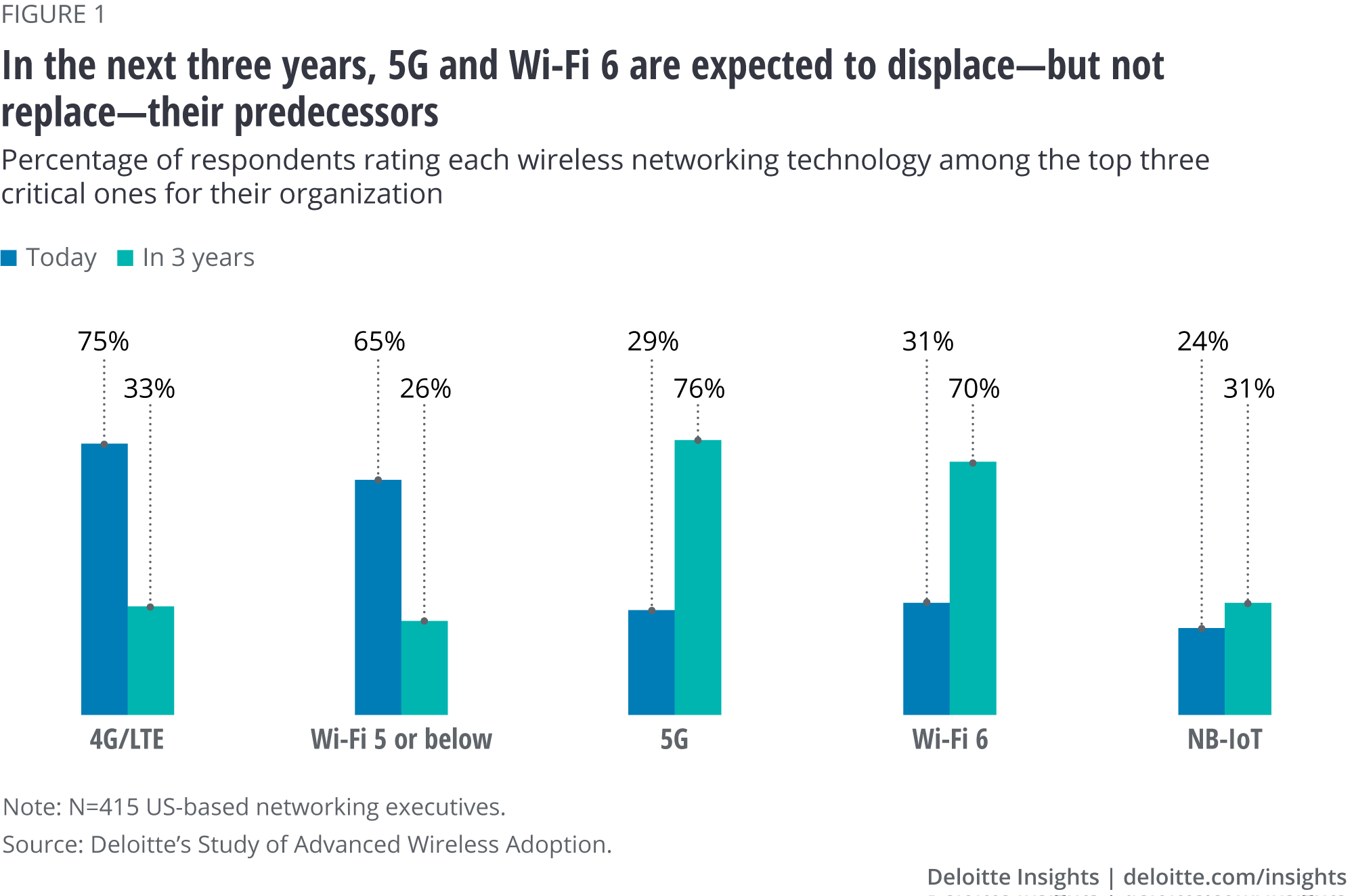
Transforming through advanced wireless connectivity
What is fueling the organizational shift from current-generation to next-generation networking technologies? To begin with, we can rule out some factors:
- Network aging isn’t driving the shift: With three-quarters of our survey respondents reporting their organization’s current wireless networks (excluding public carrier networks) are less than three years old, the shift to new technologies doesn’t appear to be due to “old age” of the current infrastructure.
- Network metrics aren’t driving the shift: More than eight in 10 of these executive decision-makers are “satisfied” or “extremely satisfied” with a range of traditional performance characteristics of their current wireless networks, including reliability and resilience, data speed, latency, coverage, location accuracy, energy efficiency, and device density. On the operational front, a similar portion are “satisfied” or “extremely satisfied” with the security of their networks and data, ability to control and customize their networks, interoperability, scalability, technology maturity, and ease of deployment. So, network metrics aren’t driving the shift either.
What is driving the expected shift to next-gen wireless networking then? There are signs that organizations are looking beyond traditional network metrics such as reliability and coverage and are instead adopting advanced wireless to unlock competitive advantage and create new avenues for innovation in their operations and offerings. Among the surveyed executives:
- Fifty-seven percent believe their company’s current networking infrastructure prevents them from addressing the innovative use cases they would like to target.
- Eighty-seven percent believe their company can create a significant competitive advantage by leveraging advanced wireless technologies. Indeed, when executives were asked to describe why they believe advanced wireless technologies will be highly important to their business three years from now, “competitive advantage” was the most common theme, followed by efficiency/optimization and keeping up with new technology.
Organizations moving to advanced wireless are very optimistic about their ability to leverage the new technologies to innovate and compete. Moreover, 86% of the executives surveyed believe that advanced wireless will substantially transform their organizations within three years, and 79% say the same about the effect of these technologies on their industry (figure 2). Remarkably, these numbers are even higher than the proportion of AI-adopting executives who believe that AI technologies will transform their businesses and industries within three years, according to a recent Deloitte study of AI in the enterprise.3 This strong belief in the transformative power of advanced wireless connectivity is especially impressive, considering that both 5G and Wi-Fi 6 are the latest generations of technologies that originated more than 20 years ago and have been evolving ever since.4
Eighty-six percent of networking executives surveyed believe advanced wireless will transform their organization within three years and 79% say the same about their industry.
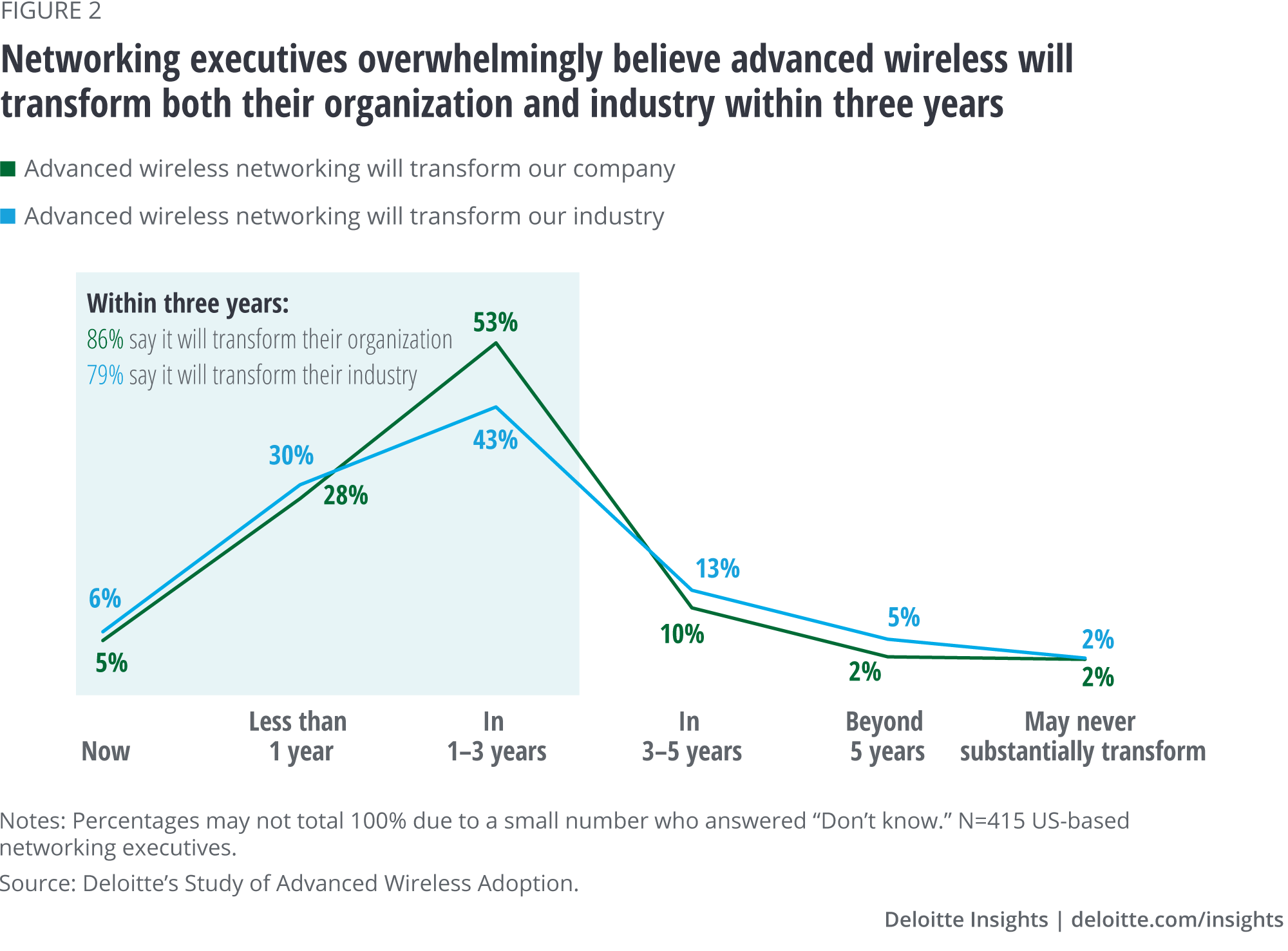
Adopting advanced wireless is regarded as a strategic necessity: Networking executives are likely feeling a sense of urgency to take advantage of these new technologies since their industry peers are transforming almost as fast as their own organizations. What kind of benefits do adopters aim to achieve with their shift to advanced wireless networking? The top three objectives are improving efficiency, improving security, and taking advantage of new technologies, such as edge computing, big data analytics, and AI (figure 3).
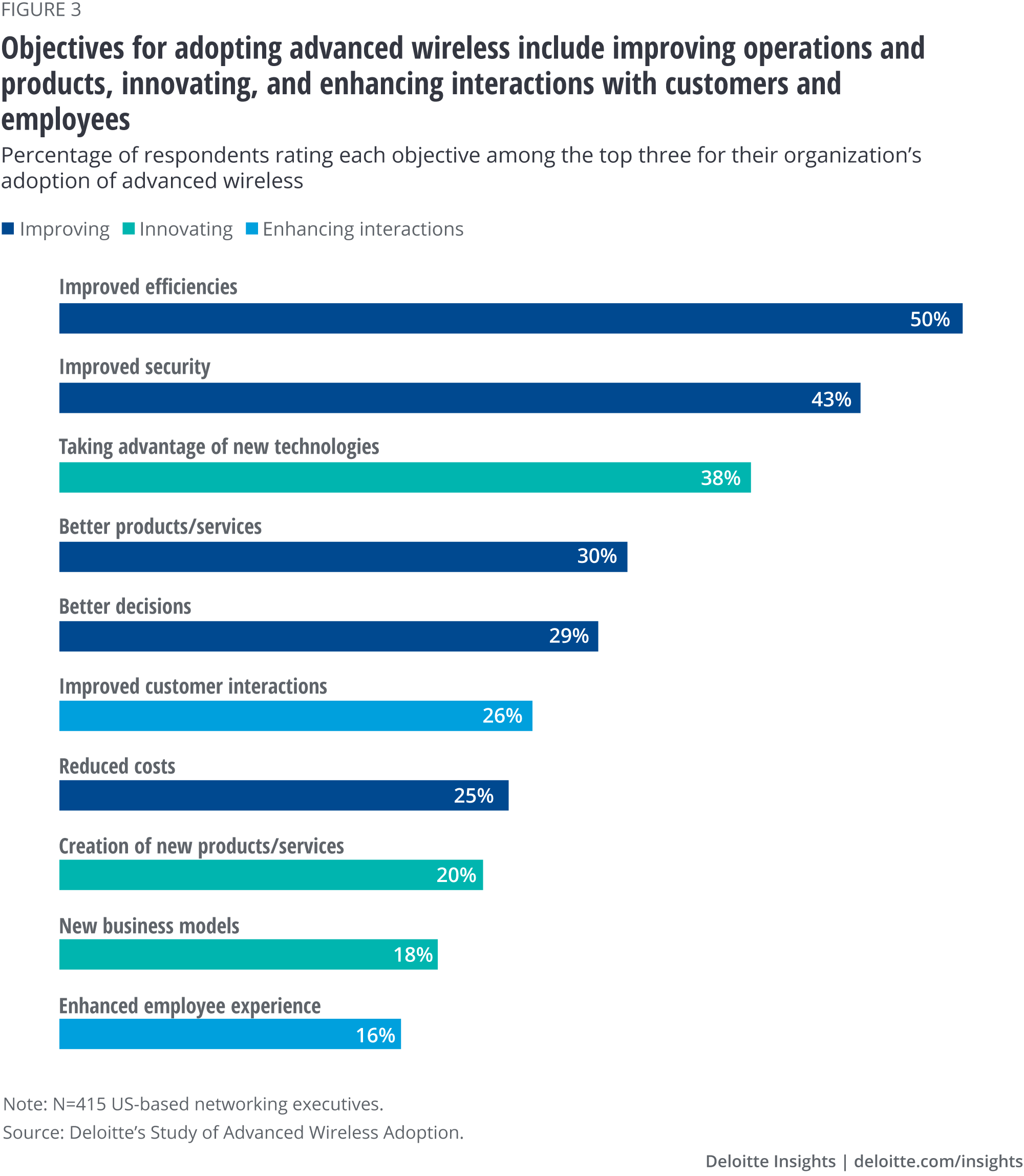
The pronounced desire to leverage new technologies reveals a strong ambition to pursue innovation by adopting advanced wireless. Indeed, organizations view advanced wireless connectivity as a force multiplier that enables them to unlock the full potential of other emerging technologies (figure 4). More than eight in 10 believe advanced wireless connectivity is “very” or “extremely important” to their organization’s ability to take full advantage of AI, edge computing, IoT, cloud, and big data analytics. This is likely a key reason they view next-generation networking as transformative (see sidebar, “Synergies between advanced wireless and other emerging technologies”).
Organizations view advanced wireless connectivity as a force multiplier that enables them to unlock the full potential of other emerging technologies.
The adoption of new wireless technologies may usher in an era of more connected devices than ever before, with massive amounts of data flowing between people and machines. By collecting, analyzing, and rapidly making sense of the tsunami of data from hyperconnected things, technologies such as IoT, edge and cloud computing, big data analytics, and AI are also crucial to achieving the goal of improving efficiency, whether that be in a smart city, factory, hospital campus, or elsewhere.
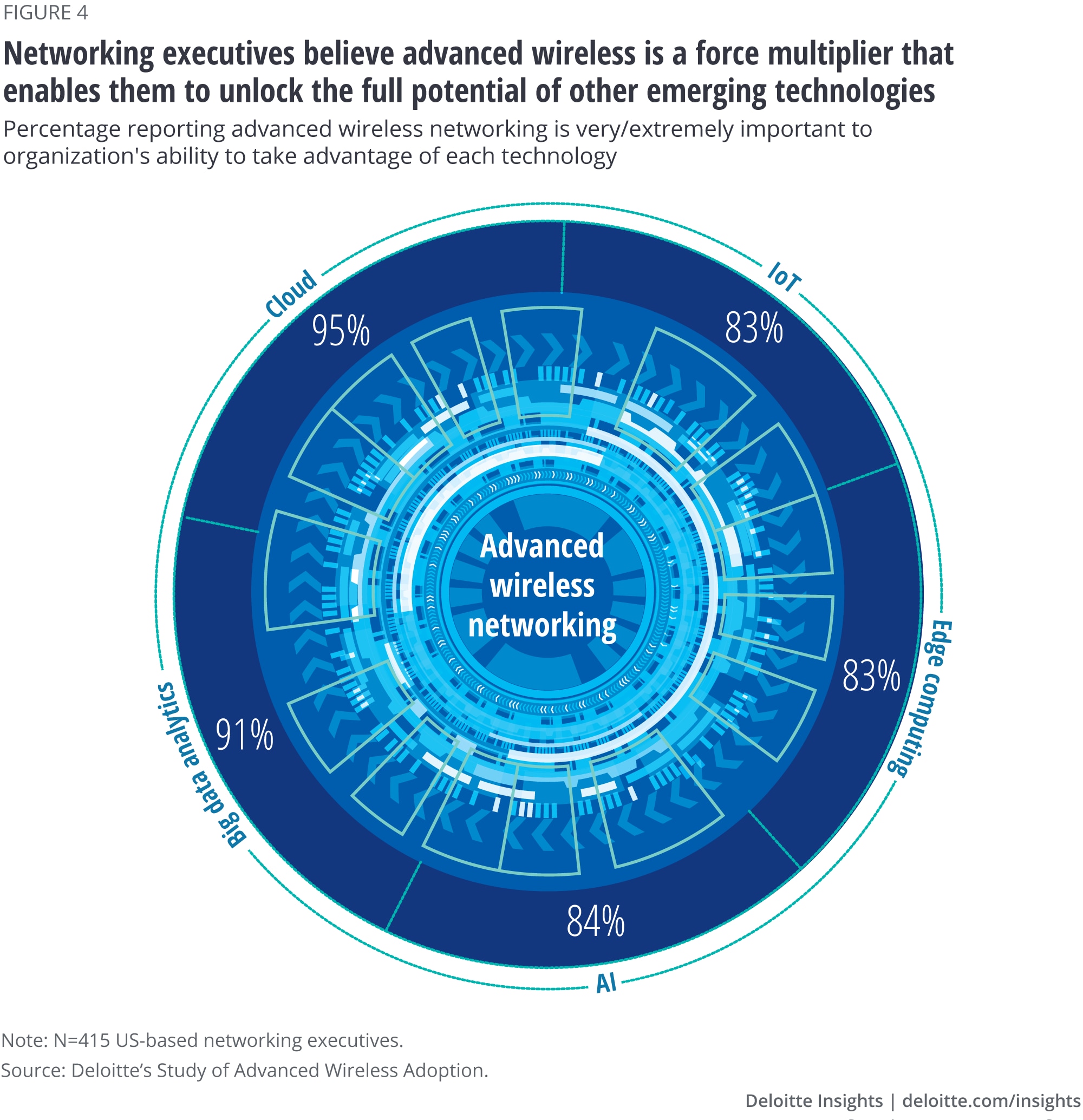
While organizations report being largely satisfied with the security of their current networks and data, the hyperconnectivity enabled by advanced wireless raises some new security concerns. The more connected devices, the more potential network entry points that need to be protected, and enterprises are keenly aware that they can’t take their eyes off the security ball.5 At the same time, new connectivity technologies promise better security; for example, 5G slicing supports unique security policies per slice, which has the potential to increase security—as long as slices are configured and managed properly.6
Synergies between advanced wireless and other emerging technologies
Pairing 5G with edge computing can enable real-time services
While most data analytics is still performed in powerful cloud servers, edge computing—the ability to analyze data closer to where it’s generated—is rapidly becoming a reality. 5G and edge computing are complementary. As a case in point, Lufthansa Technik is partnering with a wireless carrier and device manufacturer to set up two private standalone 5G networks in aircraft hangars to support remote engine inspection and maintenance, as well as remote 3D interior cabin design. As they inspect aircraft components, on-site mechanics can transmit large, data-rich images and live video, collaborating on real-time changes with off-site engineers. Technicians can use augmented reality (AR) in an empty airplane fuselage to visualize the planned 3D design. Besides providing reliable, high-bandwidth coverage over large hangar areas, these 5G standalone networks use multiaccess edge computing to analyze sensitive proprietary data on premise in real time. Benefits may include faster response times, enhanced security, and potentially lower costs.7
AI, IoT, and 5G meet at the intelligent edge to make cities more efficient
Las Vegas officials, in an effort to make their city run more smoothly, are deploying a private 5G network to support smart city projects; for instance, connecting IoT sensors and cameras mounted on traffic light poles to better manage traffic flows at intersections.8 Images are sent to edge servers, where AI analyzes them to determine volume, direction, and flow of vehicles. The goal is to understand traffic patterns in real time, adjusting signal timing and digital signage to ease congestion; city leaders hope to achieve efficiency gains of up to 40%.9
How adoption of advanced wireless is unfolding
Leading the charge
It’s interesting to note who is leading the charge to innovate and transform with advanced wireless connectivity. IT roles—from CIOs and CTOs to managers—are seen as driving next-gen wireless networking adoption (figure 5). Business and operational leaders also play a prominent role, with almost half of surveyed executives reporting that CEOs or presidents drive wireless adoption at their enterprises, reinforcing the strategic importance of advanced wireless to the business. Adoption appears to be led both top-down by executives and also bottom-up by IT managers—suggesting that many of the current efforts are likely still in an experimental phase, run as pilots by IT groups.10
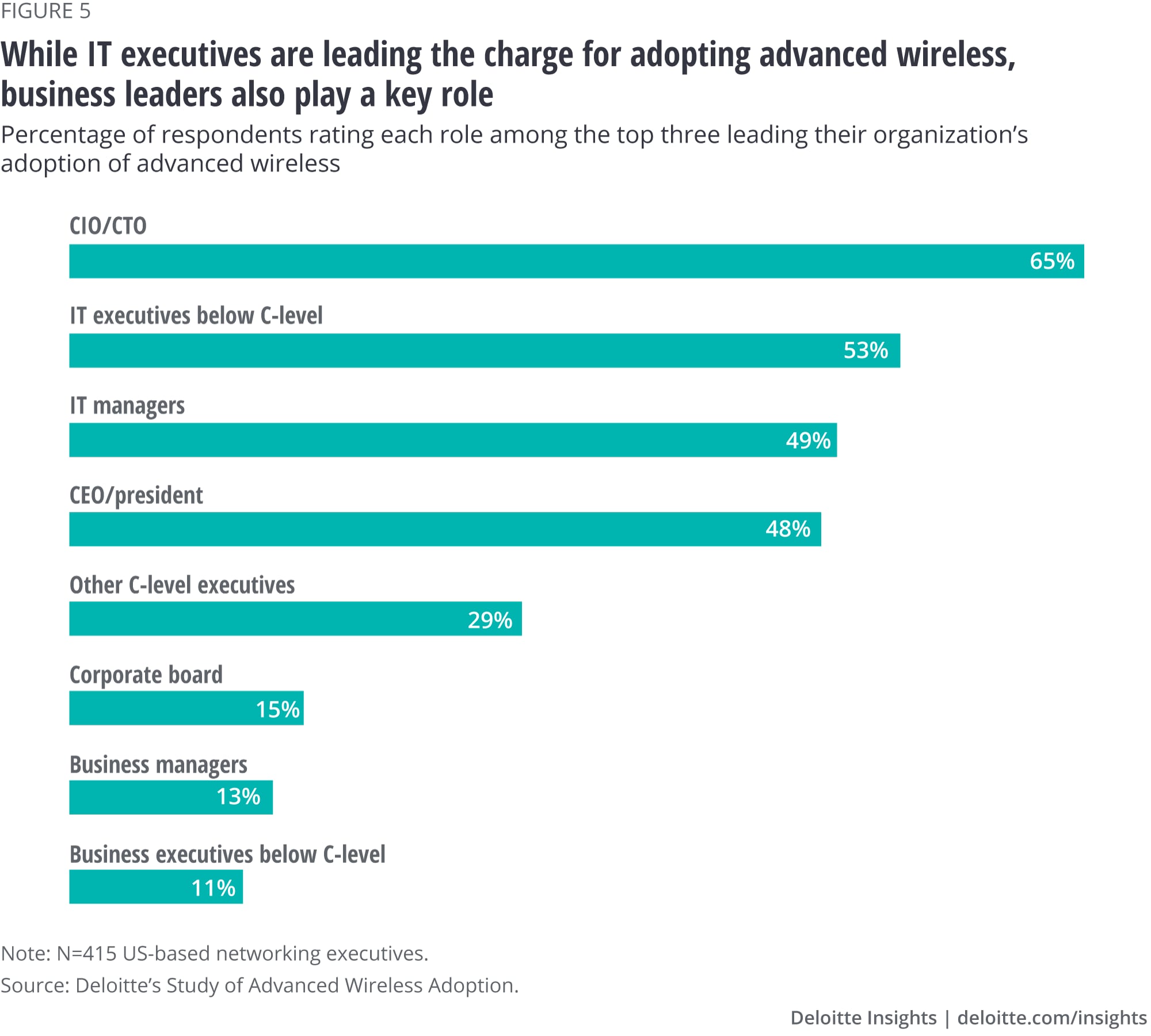
Usage scenarios for advanced wireless
The vast majority of enterprises we surveyed are targeting a blend of scenarios with their adoption of advanced wireless networks—involving both indoor and outdoor usage, and stationary and mobile devices. They aim to connect employees, machines, and customers via next-generation wireless networks—and a majority of the networking executives (61%) say they are responsible for all three of these areas. While organizations currently use wireless primarily to connect employees, advanced wireless technologies can enable many new applications for machine and customer networking.
While organizations currently use wireless primarily to connect employees, advanced wireless technologies can enable many new applications for machine and customer networking.
With regard to networking employees—both on‐site and outside the office—enterprises see advanced wireless as a way to improve workplace communication and collaboration, as well as to improve IT administration (figure 6). For example, offices may use Wi-Fi 6 to increase the speed and quality of voice and video applications, and potentially to free workers from wired connections and desktop phones.11 With a growing number of employees working remotely in the field and at home, enterprises seek to use advanced wireless to improve productivity. 5G, for example, can augment opportunities to collaborate and share data through high-resolution images, videos, and eventually 3D immersive (AR/VR) experiences.
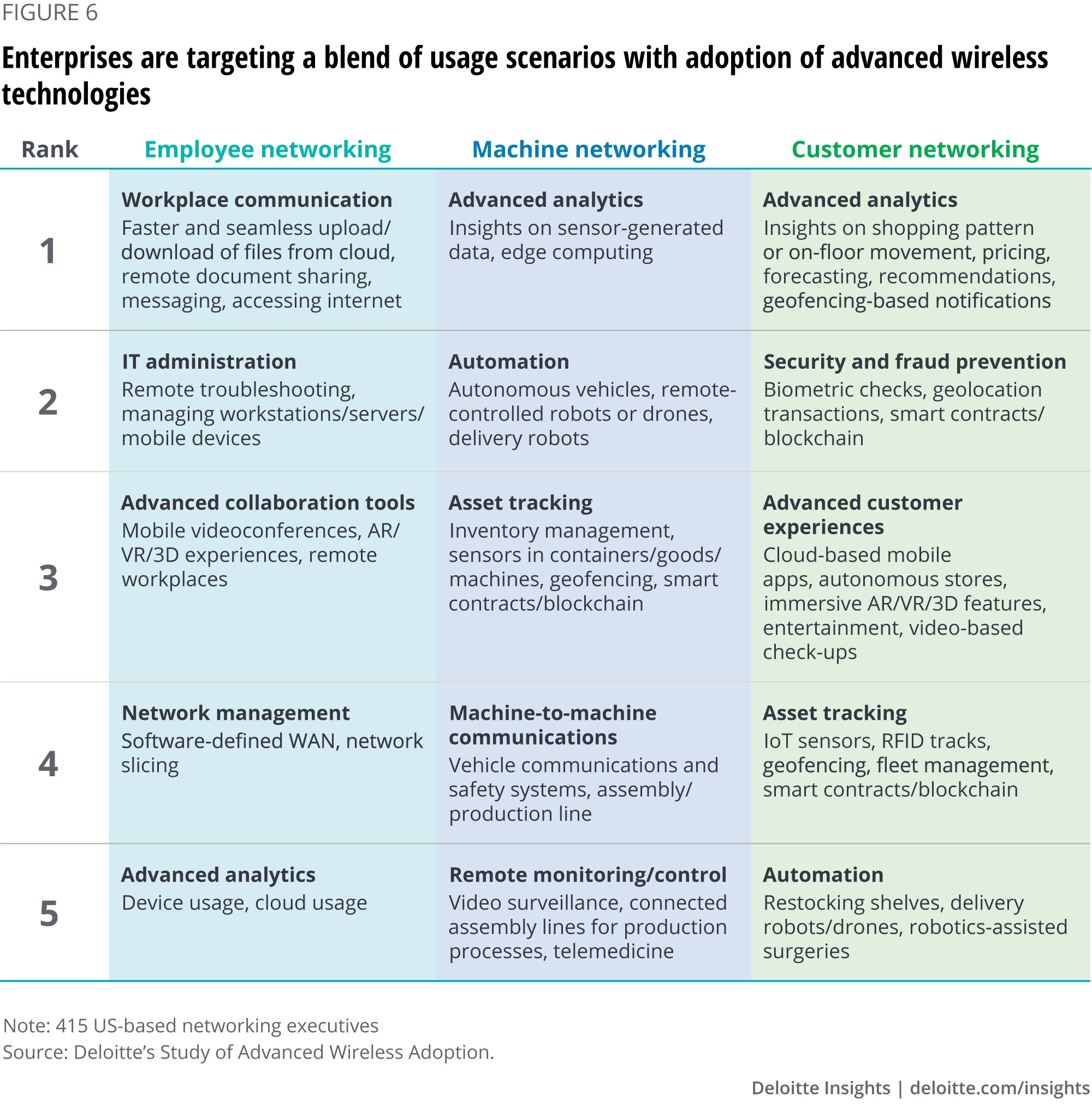
Advanced wireless technologies can play a crucial role in connecting machines and devices—inside buildings, on campuses, and in the external world—and in driving smart factory solutions. In contrast to past generations of wireless, 5G cellular and Wi-Fi 6 networks can interoperate seamlessly with one another, improving the ability to track products on the assembly line, synchronize production systems and machinery, and reconfigure production to meet market demand—without sensitive production data ever leaving the premises. 5G is also capable of delivering ultra-reliable, low-latency communication to drive human-robot interactions, offering manufacturers the opportunity to replace inflexible wired ethernet connections.
And in an era in which organizations across different sectors seek opportunities to engage directly with their customers, advanced wireless technologies may prove a real game-changer. Beyond enabling operational efficiencies across the supply chain, advanced wireless promises to drive new ways to personalize and enhance the customer experience. In health care, 5G and Wi-Fi 6 can work side by side to drive advances in telemedicine, remote monitoring, and disease management that benefit patient outcomes. Municipalities can use a combination of traditional and advanced wireless technologies to power smart cities, improving the effectiveness of public services through traffic monitoring and accident response. In retail, next-generation wireless initiatives may support analyzing purchase history, inventory trends, and foot traffic to optimize product development, product displays, and ordering. At sports venues, 5G and Wi-Fi 6 can be used as the foundation for more engaging, immersive fan experiences.
As one might surmise, executives emphasize different use cases, depending on which industry they represent (see sidebar, “Networking executives target different use cases depending on industry and role”). Our survey also revealed that IT and LOB executives have different priorities for their connectivity initiatives.
Networking executives target different use cases depending on industry and role
Companies in different industries target different use cases with advanced wireless. When it comes to machine networking—devices and machines communicating with each other—the top three overall use cases are advanced analytics, automation, and asset tracking. For technology, media, and telecommunications (TMT) executives, advanced analytics reigns paramount, with more rating it a top-three use case than in other industries (figure 7). TMT also places greater emphasis on remote monitoring and control than other industries; it ties (with asset tracking) as the second most popular use case. For consumer, retail, and automotive, asset tracking is the most popular, and pursued at a higher rate than in other industries. In a departure from other industries, energy, resources, and industrials places its primary focus on predictive maintenance, e.g., predicting (and potentially averting) downtime of machines.
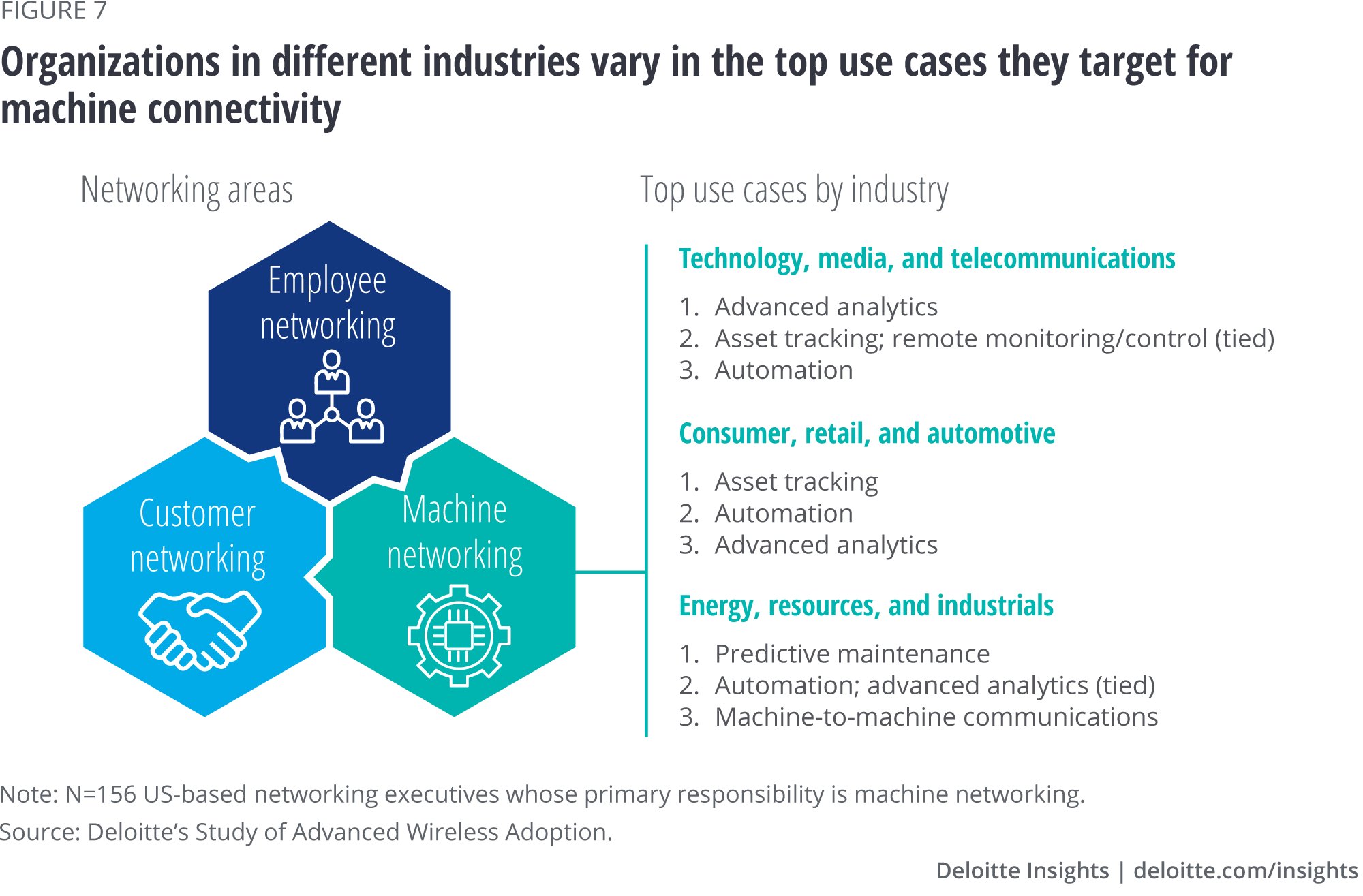
Consider employee networking—how workers’ machines and devices communicate with the company’s networks and resources. IT and LOB executives prioritize different use cases for employee connectivity. IT executives appear strongly focused on easing the work lives of employees: Workplace communication, IT administration (e.g., remote troubleshooting or management of devices), and advanced collaboration tools are the top three use cases. For LOB executives, the top two use cases are IT administration and automation—suggesting a strong desire for efficiency—followed by workplace communication and advanced collaboration. In contrast, automation appears nearly at the bottom of the list for IT executives. These differences suggest that IT and LOB decision-makers aren’t fully aligned on priorities for connectivity. It could be wise for providers of networking products and services to be mindful of these differences when engaging with their enterprise customers and crafting solutions for them.
Achieving desired benefits
To achieve the sought-after benefits from advanced wireless, what networking characteristics are organizations seeking? The executives we surveyed rate data speed, reliability and resilience, and security of networks and data as the most important attributes for realizing their objectives (figure 8).
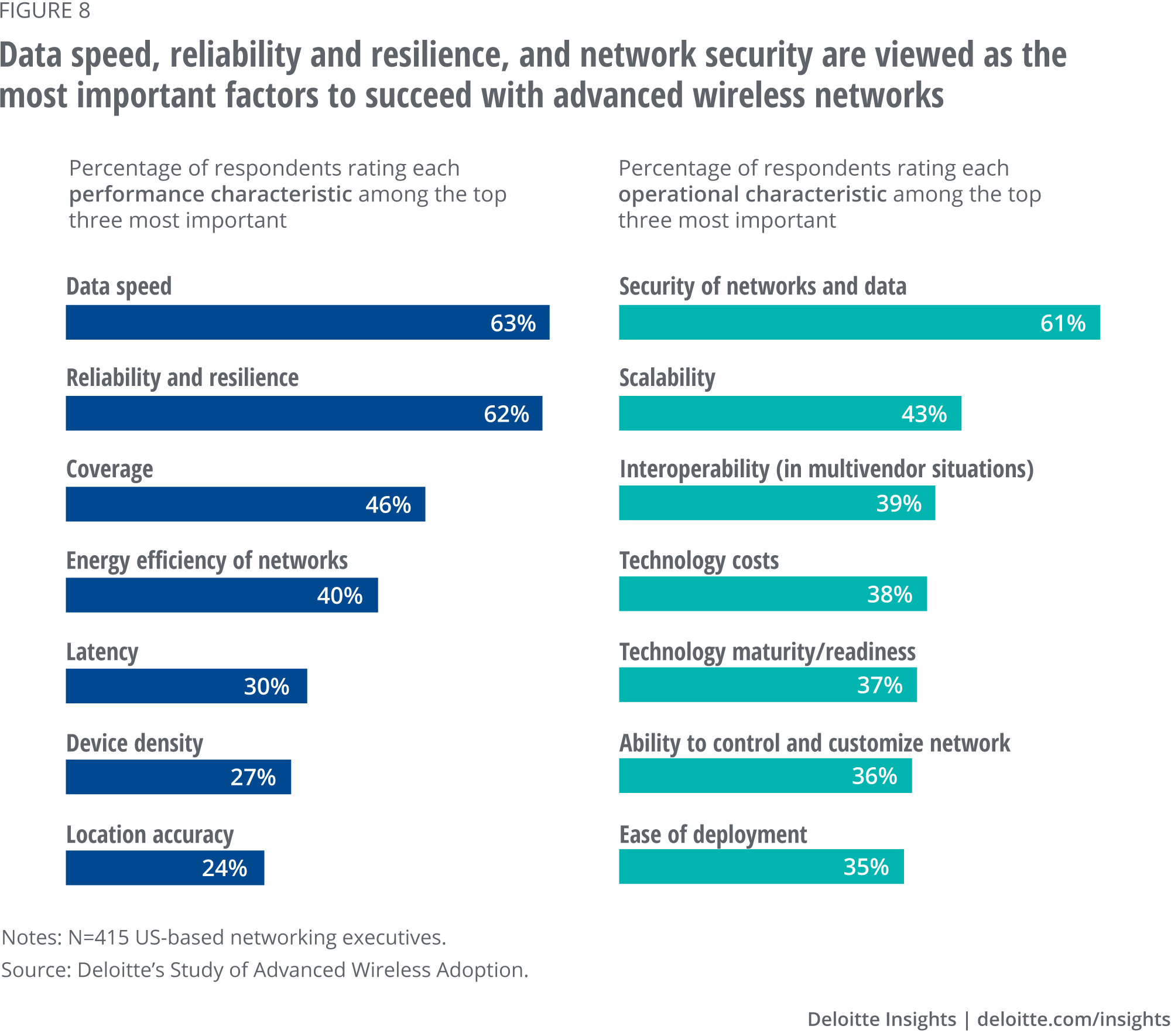
We mentioned earlier that enterprises are focused on a blend of usage scenarios: both indoor and outdoor, stationary and mobile. Respondents expressed some preference for using Wi-Fi 6 for indoor, fixed, on-campus use cases, and 5G for outdoor, mobile, and off-campus use cases. It should not be very surprising then that many of these enterprises are adopting both technologies in parallel as they pursue their goals for advanced wireless. Indeed, 14% of surveyed organizations are currently in the process of adopting both technologies (including testing and piloting); 62% plan to adopt both technologies within the next year; and 93% plan to co-adopt them within the next three years (figure 9).
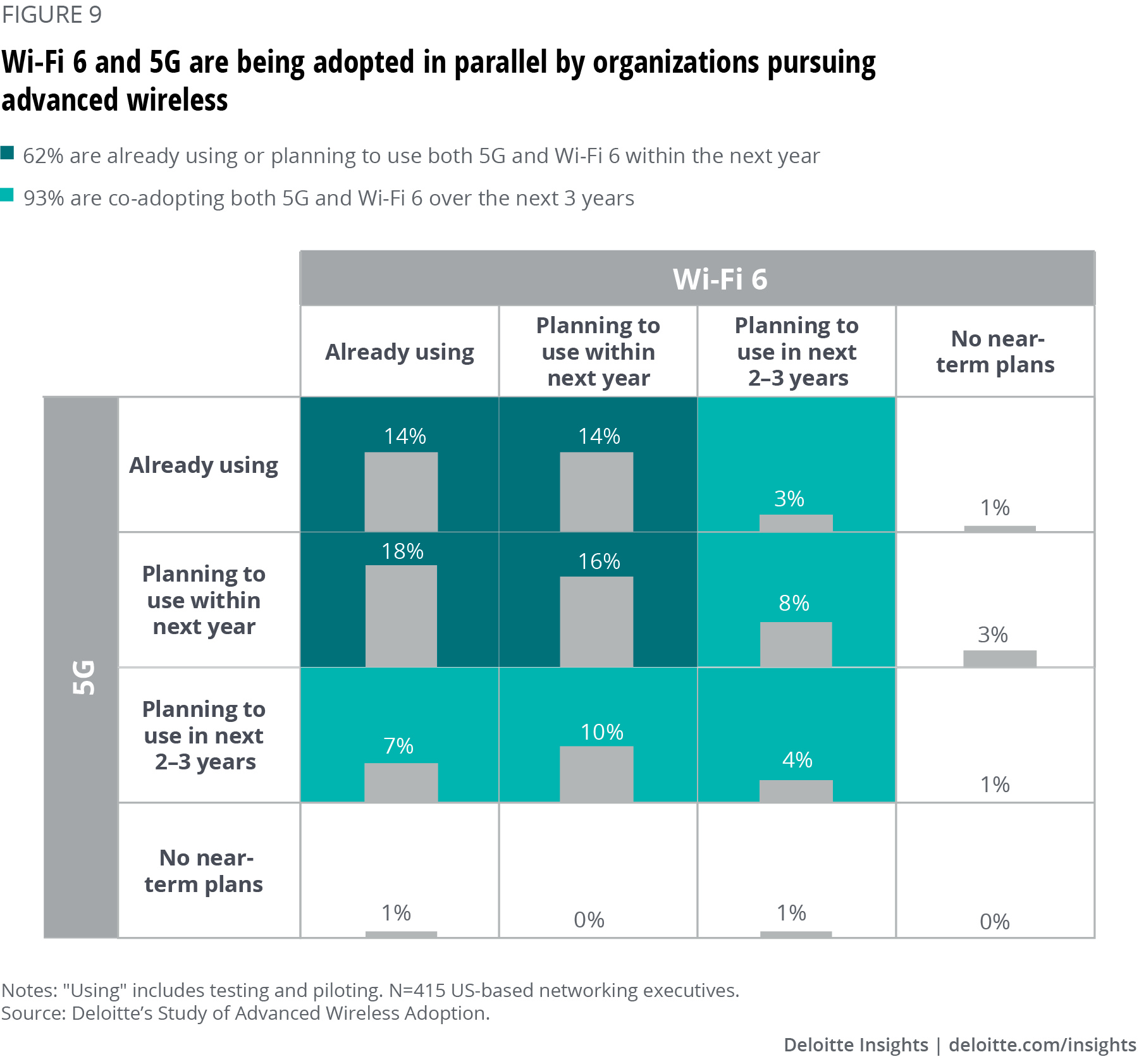
There’s a notable reason for co-adoption. Our analysis revealed that, when Wi-Fi and cellular wireless are both used, levels of satisfaction with performance and operational characteristics of networks tend to be higher. Take data speed and latency as an example. For organizations in the process of adopting (including piloting and testing) either 5G or Wi-Fi 6, but not both, about half report being “extremely satisfied” with network speed and latency. For those adopting both technologies, 58% report being “extremely satisfied” with latency, and 68% report the same for data speed.
When it comes to challenges to adopting advanced wireless, executives rated concerns around security the highest, and backward compatibility with existing systems and devices as a distant second concern (figure 10). Networking executives appear to be less worried about having adequate company commitment and funding, the ability to identify the right use cases and opportunities for ROI, technology maturity, and the ability to implement.
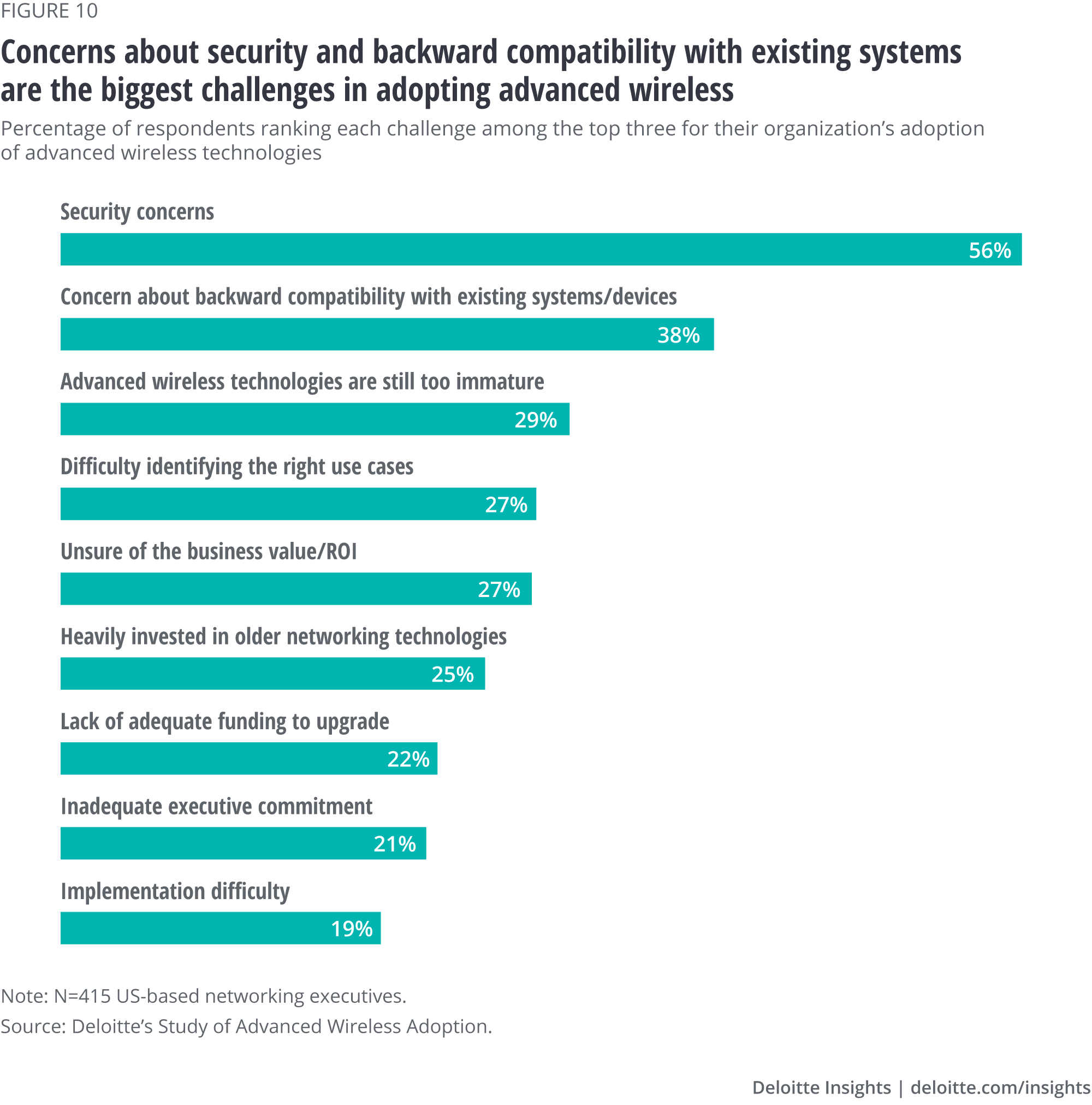
Dynamics of the emerging wireless ecosystem
Innovative partnerships
Delivering on the promise of 5G and other advanced wireless technologies involves a complex ecosystem of players, including wireless carriers, equipment manufacturers, infrastructure providers, and cloud platform providers. Putting together a complete solution generally involves bringing together capabilities and technologies from a range of providers (figure 11).
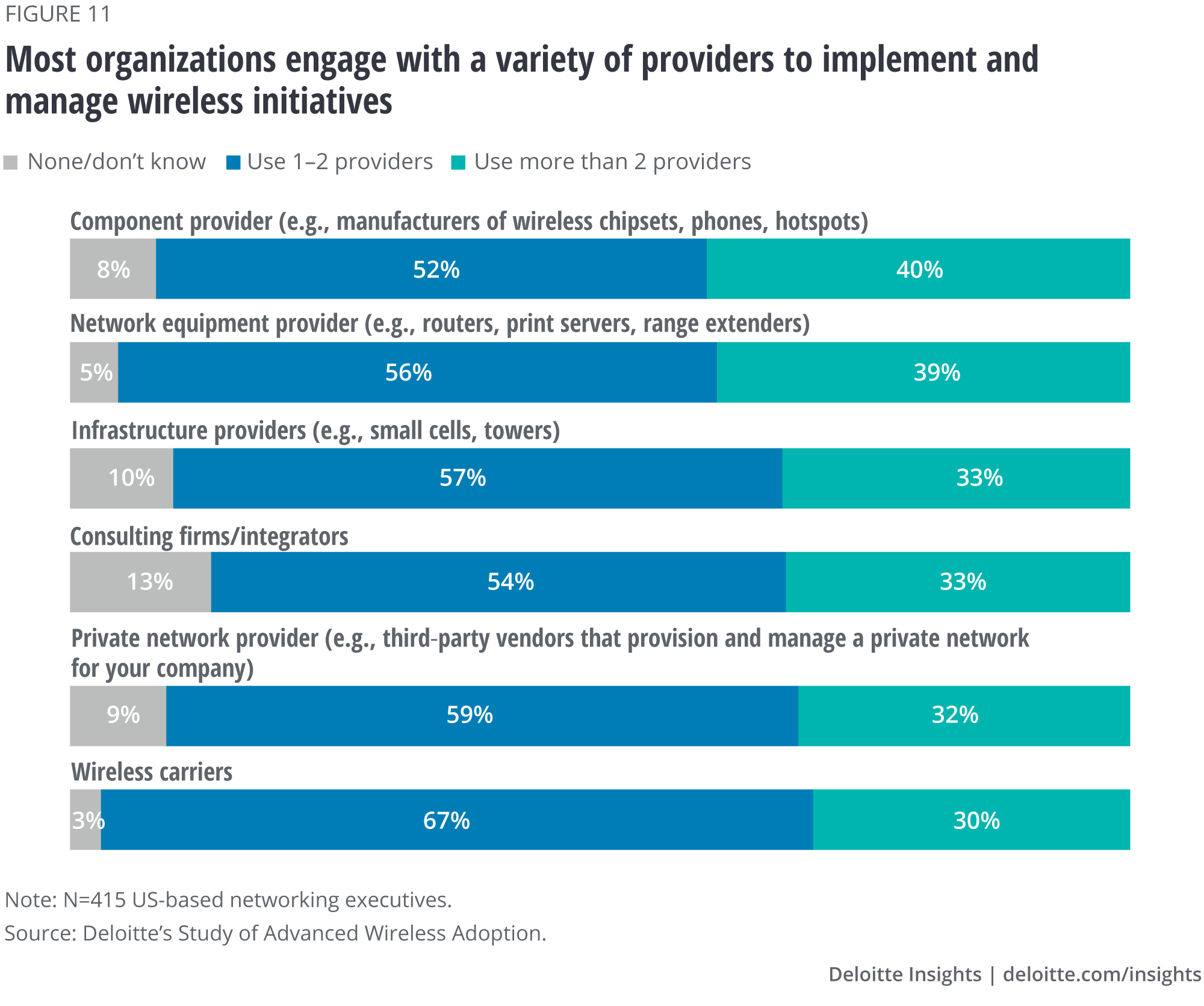
In the race to deliver complete solutions and unlock competitive advantage, the enterprise networking space is witnessing the formation of many innovative partnerships, alliances, and collaborations among both enterprises and vendors—even among parties once deemed competitors. Vendors in the wireless ecosystem—including carriers, equipment providers, tech companies, and special-purpose mobile virtual network operators (MVNOs)—are all seeking ways to capture this emerging opportunity by partnering with others to offer enterprises complete end-to-end solutions. Enterprises from manufacturers to health care providers are forming partnerships and alliances with technology vendors as they seek greater control over their future networks.
Fluid competitive landscape
5G is not just a faster and more reliable access technology, but also the genesis of a new communications network architecture. This shift in architecture is forcing established incumbents to reengineer and innovate their products and services, while also spawning new entrants that offer exciting breakthroughs in technology. The dynamic competitive environment and evolving technical standards are driving uncertainty about who will win or lose as companies jockey to become the provider of choice.
Not only do many adopters of advanced wireless engage with a wide variety of providers, but they are also very willing to explore using new providers. Across the diverse range of providers offering wireless implementation and management services—whether infrastructure, component, or network equipment providers, wireless carriers, private network providers, or consulting firms/integrators—three-quarters of advanced wireless adopters say they’re willing to reconsider the providers they use. This signals an increasingly competitive landscape in which nontraditional players and new entrants are likely to pursue new opportunities in an effort to win market share. Consider equipment manufacturers, who typically sell network equipment and software to carriers so they can offer connectivity services to their own customers. These providers are now increasingly selling equipment and services directly to enterprises that want to establish their own private 5G networks. For example, there are cases in which equipment manufacturers partner with automotive companies to trial 5G in manufacturing, to power mission-critical, time-sensitive IoT applications around robotics, AR, and autonomous vehicles.12 The advent of advanced wireless is poised to create enormous opportunity for suppliers and likely to reshape the competitive landscape.
Network management choices
Organizations should decide where and how to deploy and manage wireless networking applications in this new environment—and which providers to engage with. They should carefully consider their ability to manage, authenticate, and secure networks with thousands of devices integral to IoT and edge computing solutions. Given that security is the number one reported challenge in adopting wireless, they may be wise not to underestimate the level of risk, cost, and effort in assuming these responsibilities.
Our survey revealed that eight in 10 enterprises expect to primarily deploy and manage their wireless networking applications and services on public or private clouds in the coming years (figure 12). Of those that expect to primarily use private clouds, 21% trust their own enterprises the most to manage the private cloud data, while 60% trust traditional cloud providers (tech firms) the most.
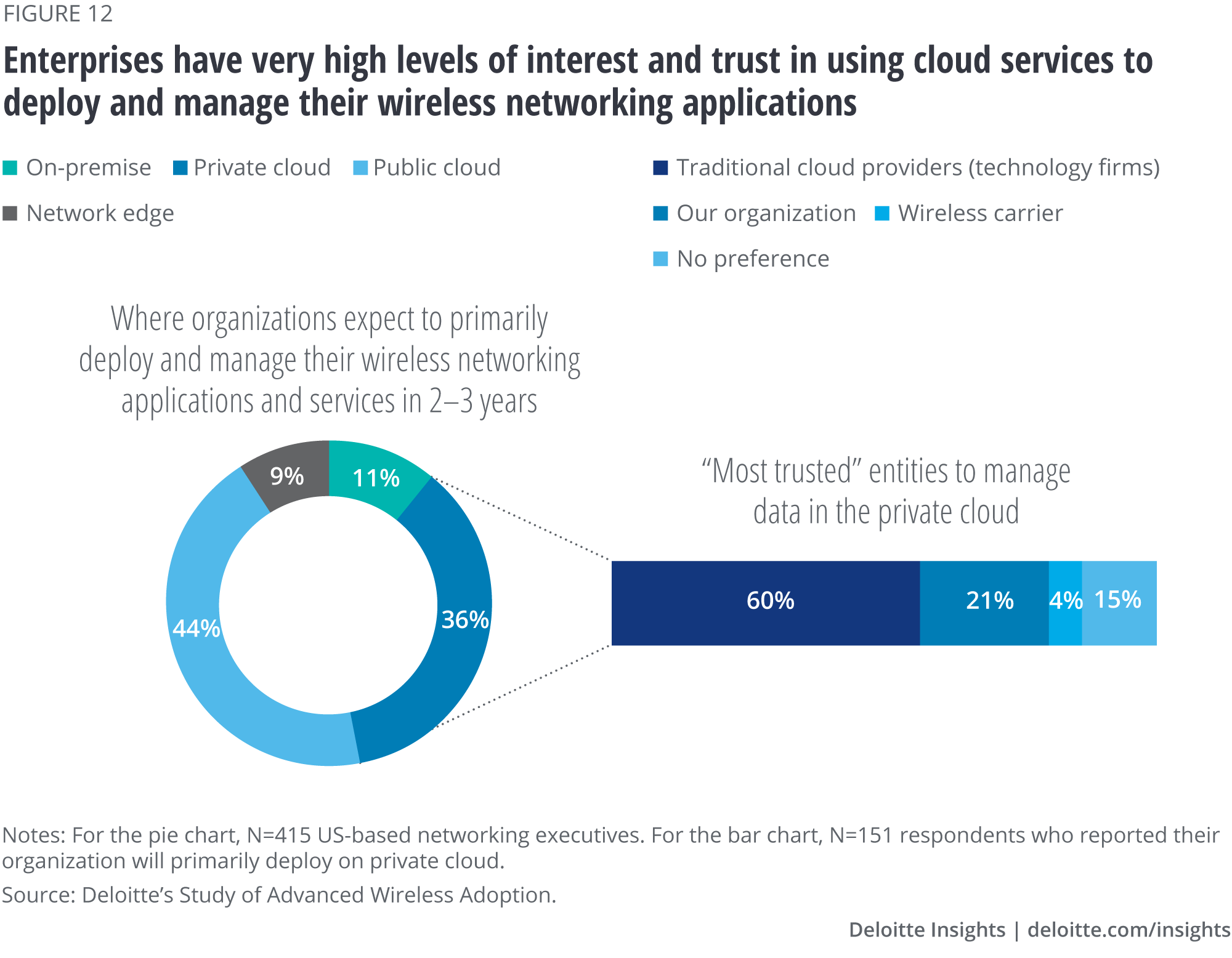
In such a complex and dynamic wireless marketplace, whom do organizations turn to as they make decisions around wireless? Advanced wireless choices are guided primarily by the organization’s own IT staff, followed by tech vendors and company executives (figure 13). Notably, tech vendors are considered as authoritative as the organization’s own executives, while wireless carriers currently lag in influence. Given their incumbent strengths in network access, WAN, and security, carriers are in a strong position to embrace the opportunity here: They can strengthen their influence by engaging with enterprise customers in new ways, e.g., in their efforts to build private networks.
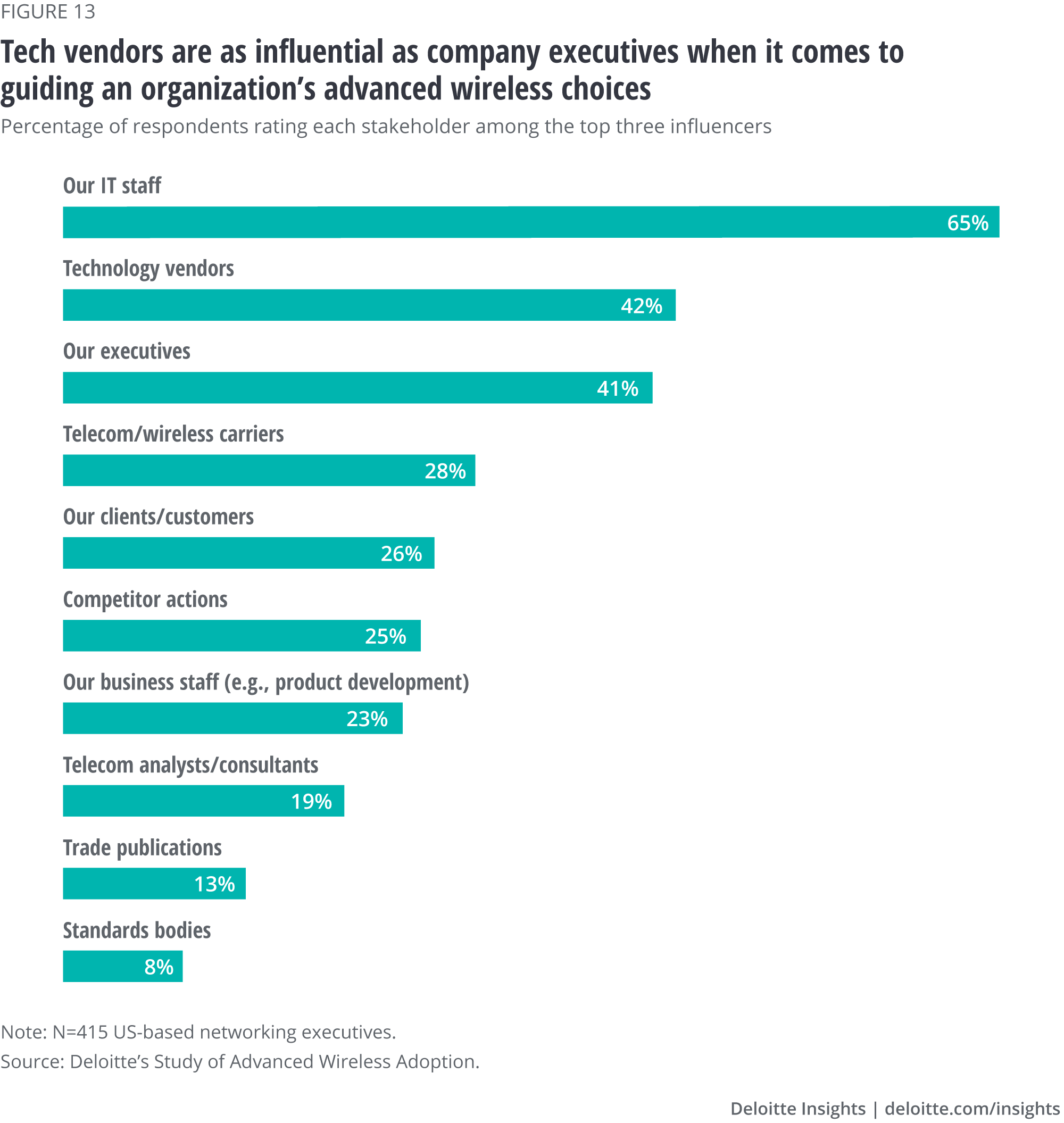
Considerations for networking decision-makers
Rollouts and adoption of advanced wireless technologies may still be in early days, but the shift to next-gen networking is undeniably underway. Enterprises moving to adopt next-gen connectivity strongly believe it has the potential to provide competitive advantage, unlock the power of other emerging technologies, and transform both their organization and industry within the next three years. But being an early adopter is not without some risk, and organizations may want to take the following considerations into account:
- Market leader or fast follower. First movers to next-gen wireless may have greater opportunities to help shape the ecosystems in which they can operate and thrive. But this greater level of influence comes at the cost of greater upfront investment, at a time when market demand for products and services may still be uncertain. However, waiting until standards and technologies are fully developed carries risks of its own, such as missing out on opportunities to begin establishing partnerships and alliances. Consider which approach is right for different parts of your business.
- Strategy and road map. Consider developing company guidelines for adopting advanced wireless technologies, and eventually a comprehensive strategy and technology road map outlining the organization’s wireless initiatives. Recognize that greater connectivity will likely generate unprecedented volumes of data, necessitating thoughtful strategies and policies on how to best store, secure, and analyze it, while being careful not to penalize any single use case with the full costs of the new technology.
- Technology toolbox. While Wi-Fi 6 or 5G (or another advanced connectivity technology) may be the most appropriate choice for certain scenarios, the most successful adopters are likely to be those with the ability to deploy multiple technologies and the know-how to make diverse networks interoperate as needed.
- Experimentation and scaling. Start by evaluating existing or potential opportunities that can leverage the unique features of more advanced wireless technologies. Consider experiments or pilots at a departmental or business unit level, and scaling early successes to larger, organizationwide initiatives. Starting efforts early, while standards and capabilities are still evolving, may help position your organization to undertake broader, more complex initiatives as the technologies continue to mature.
- Benefits and offerings. Think broadly about potential benefits of advanced wireless and how and where you can apply them. Think beyond incremental improvement and imagine how advanced wireless may help with innovation—creating new products, services, and business models—and enhancing interaction with customers and employees. Consider how you can use these technologies to create offerings that will differentiate your organization from competitors. To truly pursue transformational benefits, consider how advanced wireless can be a force multiplier for other emerging technologies such as IoT, AI, cloud, and edge computing.
- Partnering. As your organization builds out advanced wireless networks, assess whether to go it alone or establish partnerships. Think about which partners can help guide your decision-making, and which can help with execution, such as managing and securing networks. As you think about transformational initiatives, consider who you may rely on as your trusted innovation partners, providing the right expertise in areas such as AI, IoT, cloud, and edge to help you realize your vision faster.
And we’ve seen that the competitive dynamics of the wireless ecosystem are exceptionally fluid, offering both great opportunity and potential risk for providers as they jockey for position. Providers of next-gen networking products and services may wish to consider the following:
- Ecosystem positioning. With three-quarters of adopters willing to consider new providers for wireless implementation and management services, the playing field for providers is wide open. Consider carefully where you can add the most value and carve out your position. Adopters of advanced wireless are likely to seek partners to help with both decision-making and execution. Think about teaming up with other players to offer an even more attractive value proposition to adopters.
- Trust and influence. As we noted, some providers may have an uphill battle building trust and influence with adopters. We’ve seen that organizations view security and backward compatibility as their biggest challenges to adoption; providers should seek to prove their expertise and value in these areas. We’ve noted that IT roles—from executives to managers—are viewed as driving next-gen wireless adoption, followed closely by business and operational leaders. Organizations that wish to amplify their influence with adopters should seek deeper engagement with all of these parties.
- Competitive advantage and transformation. We’ve seen that enterprises are adopting next-gen wireless to achieve competitive advantage and to innovate by using advanced wireless as a force multiplier for emerging technologies such as IoT, AI, and edge computing. Moreover, they believe advanced wireless technologies can catalyze a substantial transformation of their organization and industry over the next three years. Providers that view next-gen connectivity as simply adding incremental value may lose out on opportunities. Savvy providers should go beyond offering connectivity products and services and strive to become trusted partners for innovation and transformation.
As adoption of advanced wireless plays out over the next few years, both adopters and providers may be able to unlock enormous opportunities.
Explore the Telecom, media & entertainment collection
-
How will millennials and Gen Z use 5G? Article4 years ago
-
2024 Digital Media Trends Article8 months ago
-
The smartphone multiplier: Toward a trillion-dollar economy Article4 years ago
-
The most valued technology gadgets of the last decade Article4 years ago
-
Private 5G networks: Enterprise untethered Article4 years ago



















